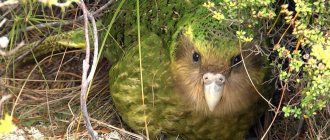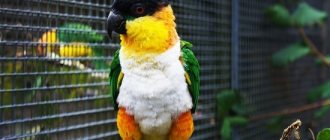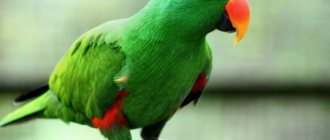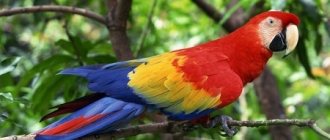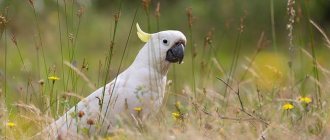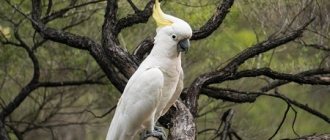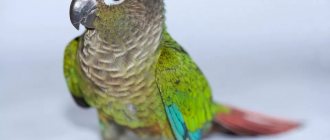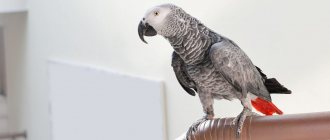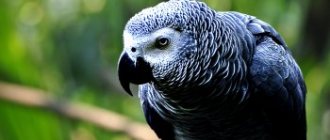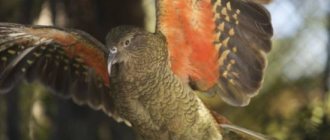- Wild animals
- >>
- Birds
The Gray parrot is a favorite pet bird for many.
He has unique abilities that distinguish him from most of his relatives. The modest coloring of the feathers is compensated by the skillful imitation of human speech and the sounds produced by many birds. Jaco learns more than a hundred words and phrases. However, even the healthiest and happiest pet creates a fair amount of clutter and noise. There are reports that Grays were kept as pets by the ancient Greeks, wealthy Romans, and even King Henry VIII and Portuguese sailors.
Origin of the species and description
Photo: Parrot zhkao
The gray parrot or gray parrot (Psittacus) is a genus of African parrots in the subfamily Psittacinae. It contains two species: the red-tailed parrot (P. erithacus) and the brown-tailed parrot (P. timneh).
Interesting fact: For many years, the two species of gray parrot were classified as subspecies of the same species. However, in 2012, BirdLife International recognized the taxa as distinct species based on genetic, morphological and vocal differences.
Gray parrots are found in primary and secondary tropical forests of West and Central Africa. This is one of the most intelligent bird species in the world. Their tendency to imitate speech and other sounds has made Grays popular as pets. The Gray parrot is important to the Yoruba people of Africa. Its feathers and tail are used to create masks worn during the religious and social festival in Geled.
Video: Gray parrot
The first recorded mention of the African gray parrot by Westerners occurred in 1402, when France occupied the Canary Islands, where the species had been introduced from Africa. As Portugal's trade relations with West Africa developed, more birds were captured and kept as pets. Gray parrot figures appear in paintings by Pieter Rubens in 1629/30, Jan Davids de Him in 1640–50 and Jan Steen 1663–65.
Arrangement of the cage
The bird is large and needs a spacious cage-aviary. The red-tailed parrot is active, loves to frolic, space should not hamper its movements. Minimum cage dimensions 65x4x80 cm
The rods must be strong and metal. The lock on the door needs to be complex, because Gray loves to solve puzzles that are aimed at his freedom of movement.
The cage for a Gray Gray should be positioned so that the bird is at the level of the owner sitting opposite. If it is higher, the bird’s character may deteriorate, as it will quickly feel its dominance. An automatic drinker and at least two feeders are placed in the cage. Accessories include a ladder, perches, a mirror, and wheeled toys.
It must be taken into account that the pet will spend most of its time “in the wild”, next to its owner. Therefore, before buying a bird, you need to prepare not only the cage, but the entire house, removing all dangerous objects. The pet must be given the opportunity to contact its owner as often as possible.
An active pet needs at least 10 hours to sleep and rest. Therefore, at night he will sleep and will not interfere with the sleep of the household members.
Appearance and features
Photo: Talking gray parrot
There are two types:
- Red-tailed Parakeet (P. erithacus): This is a dominant species, larger than the Brown-tailed Parrot, measuring about 33 cm in length. A bird with light gray feathers, an all-black beak and a cherry-red tail. Young birds have darker, duller tails at the end until their first molt, which occurs at 18 months of age. These birds also initially have gray irises, which change color to pale yellow by the time the bird is a year old;
- The brown-tailed parrot (P. timneh) is slightly smaller in size than the red-tailed parrot, but the intelligence and speaking ability remain comparable. They can range from 22 to 28 cm in total length and are considered medium sized parakeets. The browntail has a darker charcoal gray coloration, a darker burgundy tail, and a light horn-like area toward part of the upper jaw. It is endemic to its range.
The brown-tailed gray usually begins to learn to speak earlier than the red-tailed gray, since the period of maturation occurs more quickly. These parrots have a reputation for being less nervous and sensitive than the red-tailed parrot.
Grays can learn to speak within the first year, but many do not say their first word until 12–18 months. Both subspecies appear to have the same ability and tendency to produce human speech, but vocal ability and propensity can vary widely among individual birds. Gray parrots tend to use more specific calls to different species. The most famous gray parrot is Nkisi, who had a vocabulary of over 950 words and was also known for his creative use of language.
Interesting fact: Some ornithologists recognize a third and fourth species, but they are difficult to distinguish in scientific DNA studies.
Intelligence
The Jaco parrot has unique intelligence and exceptional memory. Good learning ability, dynamic, observant and curious. She copes with tasks without much difficulty and does everything with great pleasure. Easily reproduces sounds and repeats intonation. Jaco's character is not an easy one. Females are calmer and more silent than males, who often behave more irritably.
Once in the home environment, he looks closely at those around him for a long time. The taming of the Jaco occurs gradually, adaptation to home conditions occurs quickly. Gradually begin to memorize words, short phrases, perform various tricks and tasks, try to make it more difficult each time. Dedicate to studying every day, but you need to have a lot of patience. The result will not keep you waiting. Learn and develop from 2 - 3 months.
Where does the gray parrot live?
Photo: Gray parrot
The habitats of African gray parrots cover the forest belt of Central and Western Africa, including the oceanic islands of Principe and Bioko (Gulf of Guinea), where they live in mountain forests at altitudes of up to 1900 m. In West Africa, they are found in coastal countries.
The Gray's habitat includes the following countries:
- Gabon;
- Angola;
- Ghana;
- Cameroon;
- Ivory Coast;
- Congo;
- Sierra Leone;
- Kenya;
- Uganda.
The two known subspecies of African gray parrots have different ranges. Psittacus Erithacus erithicus (Red-tailed Gray) inhabits a range extending from Kenya to the eastern border of Ivory Coast, including island populations. Psittacus Erithacus Timneh (Brown-tailed Gray) has a range from the eastern border of Ivory Coast to Guinea-Bissau.
The habitat of African gray parrots is moist lowland forests, although they are also found at altitudes of up to 2200 m in the eastern part of their range. They are usually observed at forest edges, clearings, gallery forests, mangroves, wooded savannas, crop fields and gardens.
Gray parrots often visit open lands adjacent to forested areas, they live in trees above water and prefer to roost on islands in rivers. They nest in tree hollows, sometimes choosing places left by birds. In West Africa, this species undergoes seasonal movements during the dry season.
Causes of death
A common cause of the premature death of Jaco is errors in maintenance that lead to the pet's illness. Self-medication and delaying the moment of contacting an ornithologist greatly reduce the likelihood of a favorable outcome for the parrot.
There are also frequent cases of poisoning, as well as death of birds from accidents. In order for your pet to live a long and happy life, it is necessary to take timely preventive measures to prevent diseases, monitor the behavior of your feathered friend and, at the slightest sign of ill health, consult a specialist.
What does a gray parrot eat?
Photo: Gray parrot from the Red Book
African gray parrots are herbivorous birds. In the wild, they learn a complex set of skills. The Grays learn how to separate healthy food plants from toxic ones, how to find safe water, and how to reunite with their families when they are separated. They eat mainly a variety of fruits, preferring the oil palm (Elaeis guinensis).
In the wild, Grays can eat the following foods:
- nuts;
- fruits;
- green leaves;
- snails;
- insects;
- succulent shoots;
- seeds;
- grains;
- bark;
- flowers.
Feeding sites, as a rule, are located at a considerable distance and are located on elevated plains. Birds often raid fields with unripe corn, which angers the field owners. They fly from tree to tree, trying to find more ripe fruits and nuts. Grays prefer to climb branches rather than fly.
Interesting Fact: In captivity, the bird can eat bird pellets, a variety of fruits such as pear, orange, pomegranate, apple and banana, and vegetables such as carrots, boiled sweet potatoes, celery, cucumbers, fresh cabbage, peas and green beans. In addition, the Gray needs a source of calcium.
Gray parrots partly feed on the ground, so there are a number of behaviors that birds go through before perching and safely consuming food. Groups of parrots gather around a barren tree until it is completely filled with hundreds of birds preening their feathers, climbing branches, making sounds and communicating. Then the birds descend in waves to the ground. The entire group is never on the ground at the same time. Once on the ground, they are extremely alert, reacting to any movement or sound.
Now you know what a gray parrot eats, let's see how it lives in its natural environment.
Artificially eaten subspecies
Currently, there are many more subspecies of gray parrots than exist in nature. All of them were bred artificially by ornithologists.
Here are some of the new subspecies of the African gray bird:
- Gray-pink are parrots whose feather edges are pink rather than white.
- Albinos are completely white individuals.
- Yellow birds are lutinos. Their plumage is pale yellow, almost beige.
These birds can be purchased at any reputable nursery. Ornamental parrots of the yellow gray breed look bright and unusual.
The gray parrot is an exotic bird with a difficult character. If you purchase a young specimen and give it enough time and attention, you can raise an intelligent and devoted friend who will delight you with his company for many years.
Features of character and lifestyle
Photo: Domestic gray parrot
Wild African Gray parrots are very shy and rarely allow people to approach them. They are social birds and nest in large groups. They are often seen in noisy flocks, calling loudly in the mornings, evenings and in flight. The flocks consist only of gray parrots, unlike other parrot species which are found in mixed flocks. During the day, they break up into small groups and fly long distances to forage.
Grays live in trees above water and prefer to spend the night on river islands. Young birds remain in their family groups for long periods of time, up to several years. They socialize with others of their age in nursery trees, but stick to their family pack. Young parrots are looked after by older birds until they are educated and mature enough to live on their own.
Interesting fact: Young Grays exhibit respectful behavior towards older members of the pack. They learn how to behave in different situations, such as competition and defense of nest sites and raising offspring. Competition for nests during the mating season makes the species extremely aggressive.
Birds go to roost at dusk and even in the dark. They travel their way along established routes, carrying out fast and direct flights, often flapping their wings. Previously, roosting flocks were huge, often numbering up to 10,000 parrots. Early in the morning, before sunrise, small flocks leave their roosting area and go screaming to feed.
What do young parrots look like?
Gray Gray chicks have almost black irises. The skin around the eye sockets and on the paws is thin, smooth, and pink in color. The white edging of the feathers is still missing. The feathers can be milky or beige; under the tail they are not yet bright red, but dark, as if dirty.
As soon as the Gray chick becomes older than 8 months, its iris will lighten and later become bright yellow. This will happen in the third year of life. Gray chicks with gray, whitish, smoky eyes are young parrots up to 2 years old.
On a note! Gray chicks up to 1 year old are suitable for taming and training. They make contact more easily, remember new words faster, and their character is more flexible.
The plumage of Gray Gray chicks is pale gray, dirty beige, and inconspicuous. Gradually, by about a year or two, it will acquire the ash-gray color with white streaks typical of an adult.
Social structure and reproduction
Photo: Gray parrot
African Gray parrots are very social birds. Reproduction occurs in free colonies, each pair occupying its own tree. Individuals carefully select their mates and have a lifelong monogamous relationship that begins at sexual maturity, between the ages of three and five. Little is known about courtship in the wild, but observational flights around nests have been observed and recorded.
Interesting fact: Males feed their mate (nuptial feeding) and both produce soft monotonous sounds. During this time, the female will sleep in the nest, and the male will guard it. In captivity, males feed females after copulation, and both sexes engage in a mating dance in which they lower their wings.
The breeding season varies depending on the area, but appears to coincide with the dry season. African gray parrots breed once to twice a year. Females lay three to five round eggs, one at an interval of 2 to 5 days. The females incubate the eggs and feed entirely on the food brought by the male. Incubation takes about thirty days. The chicks leave the nest at the age of twelve weeks.
After the young chicks leave the nest, both parents continue to feed, raise and protect them. They care for their offspring for several years until they become independent. Life expectancy is 40 to 50 years. In captivity, African gray parrots have an average lifespan of 45 years, but can live up to 60 years. In the wild - 22.7 years.
Price
Many people wonder: how to choose a Gray and how much does it cost? Pets live on average from fifty to sixty years, so when you buy a pet, you are buying a friend for life.
Thanks to their talents, birds are very popular. There is a brown-tailed species and a red-tailed one, their cost differs significantly, due to what the species looks like. So, untrained speech in the market or on the Internet through various advertisements can be purchased for 15 - 35 thousand rubles.
It all also depends on where you purchase the animal. The cost is higher in a pet store, where their price is approximately seventy to one hundred and fifty thousand rubles. They usually have their own catalog, which can be viewed online.
Breeders have fosterlings in the price range from sixty to one hundred and twenty thousand rubles. Even those who can speak and are quite old cost from three hundred thousand rubles and even more. Don’t forget to include in the price what you will feed your pet.
Next
Gray Red-tailed Gray and all information and breed
Natural enemies of gray parrots
Photo: Gray parrot
In nature, gray parrots have few enemies. They receive the main damage from humans. Previously, local tribes killed birds for meat. West Africans believed in the magical properties of red feathers, so Grays were also destroyed for their feathers. Later, parrots began to be caught for sale. Grays are secretive, cautious birds, so it is difficult to catch an adult. The Aborigines willingly caught fledgling chicks in the net to generate income.
The gray eagle's enemy is the palm eagle or vulture (Gypohierax angolensis). The diet of this predator mainly consists of oil palm fruits. It is possible that the eagle's aggressive behavior towards the Gray Gray has a competitive significance due to food. You can watch gray parrots scatter in panic in different directions, attacked by an eagle. This was probably the protection of the feeding area by the eagle.
Natural predators for this species include:
- vultures;
- palm eagle;
- monkeys;
- hawks
Adult birds teach their offspring how to defend their territory and how to recognize and avoid predators. By feeding on the ground, African gray parrots are vulnerable to terrestrial predators. Monkeys hunt for eggs and young chicks in the nest. Several species of hawks also prey on chicks and adults. It has been found that gray parrots in captivity are susceptible to fungal infections, bacterial infections, malignant tumors, beak and feather diseases, and can become infected with tapeworms and worms.
Keeping at home
Many people dream of a pet like a Gray. In order for a feathered intellectual in captivity to feel good, not get sick and meet the owner’s expectations, it is necessary to provide him with suitable conditions. Keeping a large, loud-voiced bird at home is quite difficult, and this is primarily due to the noise it makes. As for the material base (housing, food, accessories), it is much easier to prepare. However, there are some nuances here too, which we will discuss further.
Arrangement of the cage
You should choose a cage for a Gray parrot especially carefully: this parrot requires space and convenience combined with safety.
- The structure should be created on the basis of a mesh of steel rods 3-5 mm thick. The gray parrot can bite through thinner wires and get injured. The cellular structure of the mesh is convenient because it is convenient for the parrot to climb along the intersecting rods, clinging with its beak.
- Minimum cage dimensions: 50 cm width, 80 cm length, 100 cm height. This is the necessary sanitary standard for one parrot. The more residents there are, the more spacious the room should be for them.
- There are no special requirements for the shape, but it is believed that a rectangular cage is best. The cylindrical one should be abandoned, since in the rounded space the bird will have nowhere to hide.
- It is necessary to properly arrange the inside of the cage: secure wooden perches of different diameters, hang play accessories, install feeders and drinking bowls.
It is not allowed to place the cage on the floor - there are drafts below, and it is also easier for pets (if any) to get to the bird.
Important to remember! No matter how comfortable the cage is, it cannot be done without daily walks. You need to let your pet out for a couple of hours so that it can fly and frolic.
Diet
How long Grays live at home depends to a large extent on their diet. In nature, they feed on various seeds, fruits, nuts, and succulent herbs. A complete diet for a domestic parrot contains dry cereal mixtures, sprouted grains, vegetables, fruits and herbs. During special periods of life (molting, breeding season), birds need mineral and vitamin supplements.
Among commercially produced gray food, mixtures are suitable for large parrots. Every day the bird should eat about 3 tablespoons of dry assortment. If you feed your parrot a large amount of food, it may become overweight, especially if it leads a sedentary lifestyle.
Parrots love soft grains collected at the milk stage. It is difficult to provide such food at home, but there is an alternative option - a germination kit. Dry grain is moistened and kept warm for 2-3 days, obtaining soft sprouts that are tasty and healthy for Grays.
Care and hygiene
Proper care of a parrot in terms of hygiene means regularly cleaning and disinfecting the cage and perches, washing feeders and drinking bowls, and organizing bathing for the parrot himself.
Grays are generally not afraid of water. On the contrary, they look for every opportunity to swim. Hearing the sound of water flowing in the bathroom, the gray parrot flies there and joyfully climbs under the stream. Splashes with pleasure in a basin, bathing suit, or sink. Bathing helps poultry to normalize body temperature, relieve itching, and freshen up. In addition, water procedures for Grays are one of the elements of the game.
Parrots independently monitor the cleanliness of their feathers - they lubricate them, pluck out broken ones, arrange them side by side, and stir up the fluffs. The beak is also the subject of attention - the gray gray grinds off the horny tissue, running along the perch first with one side of the beak, then with the other. The claws shorten involuntarily as the bird moves or when the parrot grips the perch with its fingers.
Important: excessively long claws make it difficult for the parrot to move and cling to the fabric. They need to be trimmed in time, otherwise injuries are inevitable.
Diseases and their prevention
Diseases of parrots are infectious, non-infectious and parasitic. In gray parrots living in houses, infectious diseases are rare. Birds purchased from dubious places pose a danger. After purchase, the Gray must sit in a cage in quarantine for 2-3 weeks. At this time, he should not be allowed to go for a walk or be allowed to come into contact with other pets and birds. If the quarantine is followed according to all the rules, the risk of infection with helminths, ticks and viral infections is minimized.
Parrots are social birds that, with a lack of attention, become depressed and sometimes begin to pluck feathers. Grays have a much more pronounced tendency to self-pluck than other parrots. This is a psychological disease, sometimes incurable. Occurs only in birds living in captivity, especially after suffering stress.
Jaco after self-plucking
Other diseases are quite common in Grays, such as indigestion, inflammation of joints and mucous membranes, and vitamin deficiency. They are relatively easy to deal with, but it is better to avoid them.
So that there is no reason to wonder how long a gray parrot lives, you need to care for it:
- monitor the indoor microclimate;
- ensure good sanitary condition of the cage and accessories;
- buy high-quality, fresh food.
Preventive measures include regular visits to the veterinarian, as well as independent daily examination of the pet.
Causes of death
In the wild, gray parrots have many enemies, but when kept indoors, long-lived birds seem to have nothing to fear. Nevertheless, the domestic Gray is not immune from premature death. The length of time a Gray Gray lives with its owner is influenced by the owner’s forethought or negligence. Most often, tame parrots die due to oversight:
- from electric shock through a broken electrical wire;
- having received an injury incompatible with life (being crushed by a door, unnoticed and suffocated in a heap of things);
- freezing near an open window in winter;
- from attacks by domestic animals.
Unobvious causes of death are associated with the gradual accumulation of toxic substances in the body. Aerosols, essential oils, tobacco smoke, and fumes of chemicals contained in household items and liquids are toxic to parrots. One of the common causes of death of parrots is poisoning with bad food.
Jaco, with his intelligence, level of development and tendency to become attached to people, becomes a member of the family. The loss of a pet is not easy to come to terms with, which is why it is so important to monitor its health and never leave it unattended outside its cage.
Population and species status
Photo: Gray parrot
A recent analysis of Gray Gray populations showed the bird's dismal situation in the wild. Up to 21% of the world's population is captured annually. Unfortunately, there is no law prohibiting the capture and trade of parrots. In addition, the numbers of these birds are affected by habitat destruction, indiscriminate use of pesticides and hunting by local residents. The wild bird trade trap is the main cause of the decline in wild African gray parrot populations.
Interesting fact: Estimates of the total wild gray population at the beginning of the 21st century have varied as high as 13 million, although accurate surveys have been impossible because the parrots live in isolated, often politically unstable regions.
The Gray Gray species is endemic to the primary and secondary tropical forests of West and Central Africa. These parrots depend on large old trees with natural cavities, which are used by the grays for nesting. Studies in Guinea and Guinea-Bissau have shown that the relationship between species status and primary forest condition is proportionate where forests are declining, and so are gray parrot populations.
In addition, the Gray Gray is one of the hyper-traded bird species registered in CITES. In response to continued population declines, overharvest quotas, and unsustainable and illegal trade, CITES included the gray parrot in Phase VI of the CITES Significant Trade Review in 2004. This review led to recommended zero export quotas for some range countries and the decision to develop regional management plans for the species.
Diet
These birds are not picky when it comes to food. The fruits of the oil palm, which he loves in captivity, are, of course, impossible to provide him with. But they can be successfully replaced by ordinary sunflower seeds. They must be of high quality and not fried. But this is not all that a pet needs for full development.
Meals should be varied:
- twigs of bushes and fruit trees;
- any nuts except almonds;
- grain mixture (wheat, oats, corn);
- green peas, dill, spinach;
- mineral and vitamin supplements;
- vegetables and fruits.
If your pet is reluctant to eat wheat and oats, then they need to be sprouted.
You cannot feed the Gray from the owner's table, as this will lead to gastrointestinal disorders. Hot, salty and spicy foods should be kept away from the bird.
Adaptation
It is most convenient to buy chicks, since in adulthood these representatives of the parrot family can, when they find themselves in a new place with new owners, demonstrate unfriendliness. It is important to know how to care for your ward, a new pet during the adaptation period.
Thus, experts do not advise frequently approaching the bird’s cage during the first time it is in the house. You cannot let your pet fly. If it is noticeable that the bird is dissatisfied, irritated and frightened, it is better not to make sudden movements, move away to a distance, making it feel that it is safe.
Walk
Keeping a guest from tropical Africa indoors does not contradict the spirit of freedom and does not exclude the prospect of getting to know the street. Using a special harness or costume, you can make communication with your pet more varied, and you can have a fun weekend by going with him to the yard or a nearby park in the summer. The pet will be able to fly freely and will not get lost while walking in the fresh air.
The harnesses are comfortable to put on. They do not prevent the bird from spreading its wings and do not restrict movement. In some cases, costumes include a diaper. In other cases, they are identical to regular clothing, allowing the pet to feel confident and comfortable, and impress others.
INTERESTING FACTS, INFORMATION…
- Gray parrots very accurately convey the sounds of human speech. The Gray's voice can easily be confused not only with the voice of a person in general, but also with the voice of a specific person, for example, the owner. There are cases when these parrots answered questions correctly and followed orders, that is, the birds were capable of situational and associative conversation.
- Gray parrots, just like people, can be left-handed or right-handed.
- There is a known case when a gray parrot tried to imitate the movements of its owner’s hand with its foot.
- A. Bram talked about a polyglot Gray who could speak Dutch, German and French.
